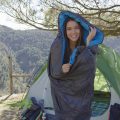Last Updated on August 2, 2023 by Dean Anderson
If you are planning on going backpacking, camping or hiking, you need to make sure that you have the components of a decent sleep system. A sleeping bag is crucial to that when you’re camping as it will keep you warm through the night, conserving body heat – it’s the outdoor replacement for a duvet.
Out in the wilderness, the temperatures can drop quickly, and you do not want to find this out on your first camping trip without a sleeping bag, or it could be the last! You probably should be looking for the best winter sleeping bag to keep you warm all while offering fantastic value for money.
In this post, you’ll find five reviews so that you can choose the right 0-degree sleeping bag for your specific camping purposes. These options are designed to provide you with protection from the cold while keeping you comfortable through a winter night in the wilderness.
If you’re not ready to choose and need to know a little more about the key features to look out for we’ve included a ton of buying advice at the bottom of this review.
1. Coleman North Rim Extreme Weather Sleeping Bag – Large and warm but not for backpackers
This will be a fantastic sleeping bag if you are planning a trip camping, where you’re driving to the campsite rather than hiking. With ComfortSmart technology by Coleman, you should feel cozy sleeping in this through the night. For a sleeping bag, it is also quite large and will fit most people up to the height of 6’2. The sleeping bag itself is actually 6’3 inches, so there isn’t that much wiggle room here. The bag is suited for temperatures between 0 and 10 degrees Fahrenheit. However, if you find yourself camping on a warm night, the bottom can be unzipped for better ventilation.
As mentioned, this sleeping bag is quite long, but that extra length does come with a price. The sleeping bag isn’t particularly compact, and you would have a hard time carrying this in all but the largest backpacks. As such, it’s best suited for pamper camping rather than trekking out into the wilderness.
The big benefit of this sleeping bag is that it will keep you warm at lower temperatures and it is durable. You won’t see much wear and tear with this sleeping bag even in rougher environments either. It also won’t cost you a fortune, and with a low price tag, it’s great value for money.
That said, larger individuals might find this bag a little too snug. Anyone over 190-lbs might want to consider one of the other, larger options on this review list.
Pros
- Great value for money
- Extra ventilation for warm nights
- Long length for taller individuals
- Comfortable at lower temperatures
Cons
- Too large for backpacking
- May not be comfortable for larger individuals
Conclusion
If you are looking for a sleeping bag suitable for car camping or on a trip where you won’t be walking long distances to the campsite, this could be a great choice. Although backpackers may wish to steer clear because it is a little large for carrying around all day. However, for those who are looking for a more relaxed camping trip, it does provide excellent value for money and comfort at colder temperatures.
2. TETON Sports LEEF Ultralight Mummy Sleeping Bag – Warm and compact but issues with the zip let it down
With this zero degrees Fahrenheit sleeping bag, you really will feel like a mummy, wrapped tightly in the lightweight yet ultra warm material. This sleeping bag utilizes body-mapping technology. The benefit of this is that it will eliminate any cold spots and potential problem areas in the bag. Coupled with a zipper draft tube, you should never feel a shiver down your spine sleeping in this bag.
As well as this, the sleeping bag, which is slightly more expensive than Coleman’s, is water resistant. It has a few other enticing features too such as protective zip storage for electronics on both sides. Finally, it comes with a Teton limited lifetime guarantee which should provide you with extra peace of mind out in the wild world.
The big benefit this bag has over Coleman’s is that it will fit snugly into a backpack. Compressed, the sleeping bag is only 8’ by 10’ so there should be no trouble taking this bag on trips for a few weeks. Although, you will definitely need to practice packing it away a few times as it can be difficult to get it fully compressed.
The bag is also suitable at lower temperatures of five degrees, camping high up in the mountains or on adventure treks. During low temperatures, the bag will keep you a toasty 20 degrees. This bag may also provide you with some level of wind resistance. Although you should not expect it to completely shield you from the wind.
Some users might not appreciate the compact design of this bag. It could be particularly unpleasant for anyone who is claustrophobic as once inside it is very difficult to move around. The design of the bag can lead to other issues as well. The zipper can come completely undone, and this can be difficult to remedy, particularly if it occurs in the middle of the night.
Pros
- Compact bag that is easy to carry around
- Perfect for backpacking and car camping
- Keeps you warm even at lower temperatures
Cons
- Zip can come undone and may be a nuisance to fix
- Tight design might be uncomfortable for some campers
Conclusion
Great for backpacking, Teton Sports Mummy Sleeping Bag could be a brilliant option for longer trips. While slightly more expensive than Coleman’s offering, it does provide some extra warmth and comes with a few useful extra features. Although anyone who has trouble with tight or confined spaces may find it difficult to sleep comfortably in this bag.
3. ALPS Mountaineering Desert Pine 0-Degree Sleeping Bag – Good for car camping but too heavy for backpackers
This sleeping bag offered by ALPS is designed to have two layers for higher levels of insulation. Made of high-quality material, the bag also has extra levels of insulation for sensitive areas of the body like the chest. As well as this, the bag can be bought in a variety of sizes for both smaller and larger individuals. The sleeping bag fits into a sack, and the design of the sleeping bag is similar in shape to the Mummy offered by Teton Sports.
The bag will certainly keep you warm at lower temperatures, as should be expected with a zero degree sleeping bag. However, similar to the Coleman the price to be paid is the size of the bag. Due to both the size and the weight (6lbs) this bag is too large for comfortable backpacking. You may also find it difficult to get the bag back in the sack it is purchased with.
That said, comfort wise, it certainly ticks off the right boxes. Even at lower temperatures, you will find this bag keeps you toasty. The main unique selling point of this product is definitely the bag in a bag design. With two separate zipping up materials it does provide a secondary layer of insulation.
Pros
- Higher levels of insulation
- Extra comfort at lower temperatures
- Available in different sizes for various body lengths
Cons
- Too heavy for backpacking
- May be slightly narrow for some users
Conclusion
This sleeping bag, while not suitable for long camping trips could be a great option if you are going car camping. The extra insulation is certainly noticeable with an extra layer of comfort. However, it does have fewer features than the lighter, more compact Mummy sleeping bag, despite offering a similar design.
4. Hyke & Byke Snowmass 0 Degree Down Sleeping Bag – Great insulation but pricey and this too has zip issues
This sleeping bag is one of the most expensive out of the items we have chosen to review. But does it still provide great value for money? The main difference between this bag and the others is that it uses a duck down insulator rather than a synthetic material. The design is a mummy bag, offering the same type of tight, compressed comfort as two of the other sleeping bags reviewed thus far. It can be purchased in two sizes – regular and tall – and is incredibly light at just 3llbs.
The main benefit of this sleeping bag is definitely the aforementioned weight. So far, many of the sleeping bags we have reviewed have been too heavy for backpacking. This can be an unfortunate issue with zero degree sleeping bags. However, the Snowmass is different and you’ll be able to hike comfortably with this on your back. In fact, you could take this camping at 11,000 ft elevation and still be perfectly comfortable.
That said, there is an issue with the bag that should make you think twice about a purchase. The zipper can jam frequently, and when it does, it can be a nuisance to get free. The outer material is also quite delicate and could tear when attempting to free the zip. This could be a serious problem for camping at lower temperatures when you need to get in your sleeping bag as quickly as possible.
Pros
- Fantastic natural insulation
- Suitable for a variety of different camping conditions
- Brilliant for backpacking and camping due to lightweight design
Cons
- Higher price
- Issues with zip getting caught
- Lightweight material could easily tear
Conclusion
Despite being one of lightest sleeping bags we have reviewed, this sleeping bag has serious issues with the zip design. For this reason, despite the benefit of being easy to carry backpacking, keen campers may want to think twice about purchasing an otherwise fantastic piece of kit.
5. Adult Sleeping Bag By TNH Outdoors – The cheapest and probably the best all-rounder on review here
The last bag for review is the Adult Sleeping Bag provided by TNH Outdoors. This bag is described as a three to four-season sleeping bag for outdoor camping with a zero degree design. The shape of the bag is again, based on the mummy design and the weight very nearly matches the 3llb offered by Hyke & Byke. At 3.6, you probably will not notice the difference.
The outer layer of the sleeping bag is waterproof which is a serious upgrade from the water resistant material offered by Teton Sports. The bag also boasts a heavy duty zipper, and it comes with a lifetime warrantee, similar to the deal offered by ALPS.
The bag provides two big benefits. The first is the waterproof outer layer. This means that if you are out hiking and it starts to rain you don’t have to worry about your sleeping bag getting wet, even if your rucksack isn’t waterproof. The other benefit is the zipper which means that the zipper won’t get trapped and you can avoid the issue you could have with the bag offered by Hyke & Byke.
Unfortunately, this bag will not keep you as warm as the previous sleeping bag reviewed. It’s perfectly suited for three seasons. While the bag can be used through the winter months, it will not provide you with the same level of comfort. Although, it does offer fantastic value for money for what it is. This is another sleeping bag small enough for backpacking. Although, you might want to think twice about taking it out for use in exceedingly low temperatures. The design of the fabric can also be quite loud when moving around, and as such, it may not be appropriate for restless sleepers.
Pros
- Lightweight enough for backpacking
- Waterproof even in heavy rain
- Heavy duty zipper avoids snags
- Good value for money
Cons
- Will not provide great levels of comfort at exceedingly low temperatures
- Best described as a three season sleeping bag
Conclusion
The sleeping bag provided by TNH Outdoors could be good for backpacking at slightly warmer temperatures. However, once the temperature drops below zero, you may find it is not as comfortable as some of the others on this list. However, the fact that the zip will not snag certainly gives it a distinct advantage over some of the other sleeping bags reviewed.
Final Judgement – The Best Winter Sleeping Bag Revealed
So, which is the best winter sleeping bag? In terms of comfort, if you are not backpacking, Coleman’s offering provides the best sleeping bag at the best value for money. However, unfortunately, for backpacking and hiking, this bag is going to be far too large to carry around. As such, unless you are going car camping you may want to avoid this option.
For backpacking and hiking the Hyke & Byke Snowmass provides the best level of comfort, even at lower temperatures. If it wasn’t for the problems with the zip and the design of the bag the duck down insulation would make it the perfect option. However, keen campers will know that any issue with the zip at all can be a serious and annoying problem, particularly at lower temperatures.
As such, the TNH outdoors sleeping bag is actually offering the best product to buy for most people. With a sturdy zip and optimum levels of comfort at higher temperatures, it is a great sleeping bag. If like my wife you really value a good nights sleep while camping this might make a great gift for friends or family.
If you’re car camping, partner this with a decent camping cot and you’ll get a great nights sleep. Backpackers should combine with a sleeping pad to just lift them from the ground and provide additional comfort.
The TNH also matches Hyke & Byke in size, and that makes it a comfortable choice for any type of camping. It may not keep you quite as warm as the Hyke & Byke at lower temperatures, but you certainly won’t freeze, and you will be able to zip up with no trouble at all.
Buying Advice
If you’re comparing models and don’t know your EN from your fill type then read the buying advice that follows, it could help you avoid an expensive mistake or a night camping where you’re too hot or too cold.
Temperature Ratings Explained
A lot of the time, people rely on the manufacturer to provide them with a temperature rating for a sleeping bag. However, there’s no need to as Europeans have come up with a standardized system known as EN. More and more manufacturers are adopting this system so you can make an informed choice.
There are three temperature ratings that are used:
- Comfort range: 0 degrees Celsius, 30 degrees Fahrenheit
- Transition range: -6 degrees Celsius, 20 degrees Fahrenheit
- Risk range: -24 degrees Celsius, -12 degrees Fahrenheit
Standard EN Ranges
Three important numbers that we need to understand are the standard EN ranges. These are:
- Comfort limit – This is the temperature in which an average woman can sleep comfortably. Generally speaking, women tend to sleep colder than men, and this is why the comfort rating is so important
- Lower limit – This is the temperature in which an average man can sleep for eight hours without waking up
- Extreme rating – This is the minimum temperature at which an average women could stay for six hours without risking death by hypothermia
However, each sleeping bag has a different style and shape, meaning that they are going to provide you with different levels of comfort. For example, if you like to have a lot of room when you sleep, you might want to make sure that your sleeping bag is spoon shaped. The issue with this is that these sleeping bags tend to feel more drafty than other styles. The shape of your bag can have a dramatic impact on how warm you are.
Fill Weight
You should also look at the fill weight of your bag. This is going to give you a good idea of how warm your bag is going to be, even if it doesn’t have an EN rating. However, you also need to look at the cut to know what level of heat retention you are going to get. For example, a slender cut bag might have less insulation, but could still be warmer.
When looking at length, this shouldn’t impact how warm you are. As long as you fit snug in your sleeping bag and are able to pull the hood up to your head to protect you and retain heat, you should be fine. Manufacturers have started to make female specific bags which tend to be smaller at the shoulders and wider at the hips. They also tend to have more insulation in targeted areas such as the feet.
Fill Power & Type
Duck & Goose Down
There are various types of fill you can consider for your sleeping bag. Duck/Goose Down fill is typically considered the best due to the fact it can be both light and warm. As well as this it’s easy to compress. That said, it is expensive and the fill power can vary dramatically.
Fill power is a measurement of down quality and shows how fluffy down clusters are. This can equate to higher or lower levels of warmth. More expensive down sleeping bags have higher fill power close to nine hundred. Cheaper ones fall down to 500. This also impacts the weight to warmth ratio with lower fill power sleeping bags needing to be heavier to provide warmth.
Synthetic
In comparison synthetic bags are cheaper but don’t provide the same warmth levels, they aren’t as compressible and can be heavier. That said, synthetic bags are typically more water resistant and thus weatherproof even compared with the latest hydrophobic down sleeping bags.
Hybrid
Alternatively, you could opt for a synthetic down hybrid sleeping bag, aimed to offer the best of both worlds. These are designed to be weather resistant and offer the warmth level of down bags but often come at a higher price.
How Much Does It Weigh And Will It Compress?
If you’re heading out car camping, you don’t need to worry about the space a sleeping bag will take or the weight. Backpackers on the other hand will need to make this a top consideration.
Sleeping bags can be incredibly light at just 1 pound but this will cost you. Cheaper choices are comparatively heavier up to about 3 pounds. If you’re looking for the lightest possible sleeping bag, down is the best choice for materials. An 800 fill power will make it seem like you’re carrying feathers on your back. Be aware though that weight can also be cut down by a thinner shell which can impact weather resistance and insulation.
If you’re looking to save space, a high level of compressibility is key and again, down comes out ahead here. Natural feathers compress beautifully and exceed synthetic possibilities. Cheaper synthetic products are going to be far less compressible in comparison. How much you can stuff down a sleeping bag will also depend on the shell and levels of insulation. A thicker shell and higher level of insulation for a synthetic bag will typically translate into less compressibility.
Most Important Parts Of Sleeping Bag
There are several notable parts of a sleeping bag you need to consider when making a purchase. These are:
- Hood: A hood will keep more heat in your sleeping back as heat will not be able to escape through the top
- Neck baffle: Stops drafts from getting into your sleeping bag, and provides you with more warmth
- Foot Box: Will allow you to sleep with your feet in a natural position, which will enhance your comfort
- Zippers: Zippers allow you control over ventilation. Partial length zippers can save weight but provide less control of ventilation. It’s also worth looking out for models that incorporate a draft tube, these prevent your legs and body from coming into contact with the cold metal of the zipper
Do You Need Weather Resistant?
Weather resistance can be a useful feature for a winter sleeping bag, particularly if you’re backpacking. Some sleeping bags are made of material that is waterproof and windproof. As such, you won’t have to worry about issues with condensation, snow melt or even light rain.
Waterproof winter sleeping bags are still made of breathable fabric and this means condensation doesn’t become an issue. The level of weather resistance will depend on the material of the sleeping bag. Typically synthetic is far more effective in wet weather however advancements including hydrophobic coatings have made down a worthy contender too.
R-Value & Finding The Right Pad
Finally, while the bulk of this guide has referred to the importance of a great winter sleeping bag, you can’t forget about the value of sleeping pads. If your pad doesn’t provide the right level of insulation from the ground, you’re going to be cold no matter how great your winter sleeping bag is.
Understanding the value of a sleeping pad is all about the R-value. This measures how insulated you will be from ground. It ranges from 1.0 up to 9.5. 1.0 provides literally no insulation whereas 9.5 means a pad is perfect for keeping warm in the winter. The R-value you need is going to depend on when you’re going camping. Generally, if you’re camping through the winter months an R-value that exceeds 5 is going to be vital.

Eight years ago, I took a risk and left a miserable office job to follow a lifestyle career that involved my love for the great outdoors. I’ve taken my love for camping, hiking and travel to the next level by running my small campground with a friend near Portland, Oregon. It’s for way less money but this has truly been a dream come true and the running involves lots of family and friends.
The next evolution of that was to get online and start allcampingstuff.com. At our campground, I spend a lot of time setting up camping equipment for customers and disposing of the garbage products they leave behind. If I can help just a few people with advice on good camping gear, then this website venture will be worth it.
So, if you want to avoid the duds and spend your money wisely you’ve hopefully come to the right place.








